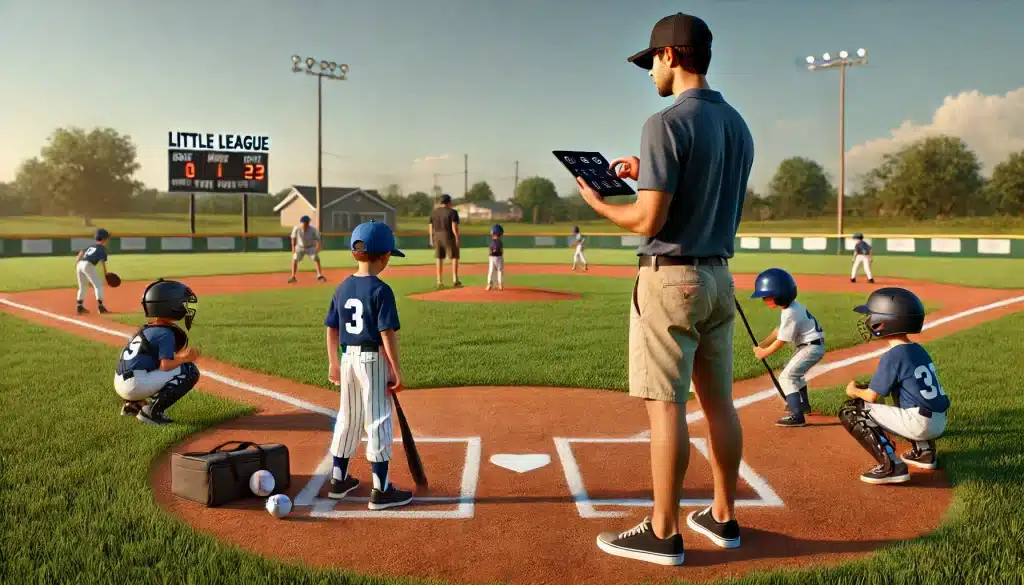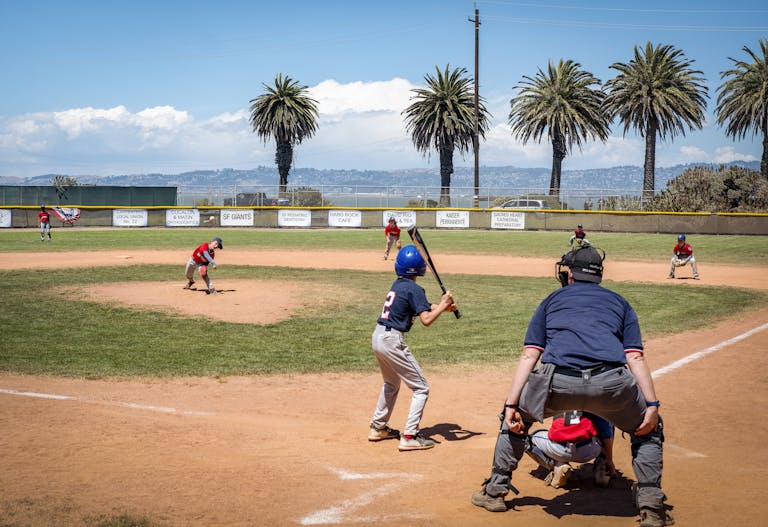7 Things Little League Coaches And Parents Should Know About Baseball Analytics
Baseball has always been a game of numbers, but the way we use those numbers has changed a lot over the years.
If you’re a Little League coach or a parent watching your child take the field, understanding baseball analytics can help you guide their development with confidence.
Whether you’re looking to fine-tune their swing, improve pitching accuracy, or simply foster a deeper love for the game, blending data with traditional coaching can make all the difference
Here are seven essential insights into baseball analytics and their role in player development.

1. Traditional Baseball Statistics Still Matter
Before diving into the world of analytics, let’s not forget the numbers that have shaped baseball for over a century.
Batting average (AVG), runs batted in (RBI), and earned run average (ERA) have long been the standard metrics for measuring performance. Why?
- They’re easy to understand. A .300 batting average? That’s a solid hitter!
- They help players and parents grasp the game by learning the basics of baseball stats.
But here’s the thing: these numbers don’t tell the full story.
Imagine two kids on your team:
- One bats .350 but only swings at perfect pitches and never walks.
- The other bats .280 but takes walks and gets on base a lot.
Which one helps the team more? Probably the second kid!
That’s why stats like on-base percentage (OBP) are now just as important as batting average.
Teaching Tip: Make Stats Fun!
Instead of just reading numbers, turn them into learning moments:
✅ Show players how one or two extra hits can boost their batting average.
✅ Track on-base percentage at practice to reward smart at-bats, not just hits.
✅ Use ERA to help young pitchers see how limiting walks helps their stats.
Bottom Line? Traditional stats are still useful—but in youth baseball, they should be teaching tools, not pressure points. The goal is development, not perfection!

2. How Moneyball Changed the Game
In 2002, the Oakland A’s, led by Billy Beane, used analytics to outsmart many of the game’s top teams, focusing on undervalued stats instead of flashy home run numbers.
This strategy—Moneyball—changed how players are evaluated and was even made into a Hollywood movie starring Brad Pitt!
Instead of just counting RBIs or batting averages, the A’s looked at:
- On-base percentage (OBP) – How often a player gets on base (not just hits).
- Wins Above Replacement (WAR) – How much a player helps the team compared to an average player.
- Walk-to-strikeout ratio – Does a hitter have good plate discipline?
- Fielding Independent Pitching (FIP) – A stat that focuses on what a pitcher controls (strikeouts, walks, home runs).
What This Means for Little League
Most kids won’t grow up playing professional baseball, but the lessons from Moneyball still apply to youth sports!
✅ Getting on base matters more than just making contact. A walk is just as valuable as a hit!
✅ Good hitters take smart risks!
✅ Smart baserunning and defense can win games, not just big hits.
How You Can Use It
Start small: Instead of just looking at batting average, track on-base percentage.
Reward kids for smart at-bats, not just big swings.
Encourage pitchers to focus on control rather than just throwing as hard as possible.
The Big Lesson?
The best players aren’t always the ones with the biggest stats—they’re the ones who do the little things right. ⚾

3. Build Skills First, Worry About Stats Later
No amount of numbers—or even the fanciest analytics—can replace fundamental skill development in youth baseball.
The golden rule? Let analytics support development, not replace it.
At this stage, the focus should be on:
✅ Age-appropriate training – No need for max-effort swings every time.
✅ Proper rest and recovery – Tired muscles lead to bad mechanics and injuries.
✅ All-around athleticism – A well-rounded athlete makes a better baseball player.
✅ Adjusting to growth spurts – A kid who grows four inches in a year will feel awkward—give them time to adjust!
For Parents & Coaches
Numbers can’t fix a bad swing or an off-target throw.
If a kid can’t make solid contact or field a routine grounder, stats won’t help—but good coaching will.
What really matters at this level?
✅ Throwing mechanics – Focus on accuracy before velocity.
✅ Swing fundamentals – A balanced, controlled swing beats an all-or-nothing home-run hack.
✅ Fielding technique – Soft hands, staying low, and keeping focus.
Sure, stats are fun—but they come second to fundamentals.
A kid who learns the right way to throw, hit, and field today will have plenty of time to worry about launch angles later! ⚾

4. Fundamentals First, Stats Second
Before diving into advanced stats, young players need to master the basics.
These core skills will carry them through every level of baseball:
✅ Throwing mechanics – Good form prevents injuries and improves accuracy.
✅ Hitting fundamentals – A balanced stance and solid hand-eye coordination matter more than exit velocity.
✅ Fielding techniques – Footwork, glove positioning, and proper angles set up great defensive plays.
✅ Baseball IQ – Knowing when to bunt, steal, or take an extra base can be a game-changer.
✅ Teamwork & strategy – Baseball is a team sport. Understanding positioning, cutoffs, and situational plays is key.
Even the best analytics in the world can’t fix poor mechanics or a lack of game awareness.
At the youth level, fundamentals always come first—good habits today lead to better players tomorrow.
Coach’s Corner
During games, focus on execution, not stats.
Instead of worrying about a player’s batting average, ask:
➡️ Did they take a good swing?
➡️ Was their footwork right on defense?
➡️ Did they make the smart baseball play?
These are the moments that build great players—no spreadsheet required. ⚾

5. Simple Technology Can Be Valuable
You don’t need high-end gadgets to track progress.
Affordable, low-tech tools can be just as effective in developing young players’ skills.
🔹 Batting tees – Reinforce swing mechanics and consistency.
🔹 Pitching targets – Improve accuracy and control.
🔹 Basic speed tools – Track running speed and agility improvements.
DIY Tip
Use your smartphone to record swings or throws.
Reviewing the footage together can pinpoint small corrections that make a big difference.
Bottom line? Development comes from practice, not pricey equipment.
Keep it simple, keep it fun, and the results will follow! ⚾

6. The Mental Game Matters More Than Numbers
Without confidence, even the most talented players will struggle.
Baseball analytics, while valuable, can sometimes overshadow the importance of a strong mental game.
For young athletes, core mental skills—self-confidence, focus, resilience, and sportsmanship—often matter more than stats.
Celebrate the wins. Learn from the losses.
Remind players that effort off the field also pays off in life beyond the diamond.
Coaching Advice
Turn mistakes into growth opportunities.
For example, instead of focusing on a poor pitching stat, emphasize what your player learned about control during that game.
Here’s the thing: analytics can’t measure a player’s mindset.
Baseball is as much about mental toughness as it is about physical skills.
- Confidence is huge. When a player believes in themselves, they’re more likely to perform at their best, regardless of the numbers.
- Teamwork matters more than any individual stat. Building strong relationships with teammates helps players perform better and feel supported.
- Dealing with failure is one of the most important lessons in baseball. Analytics can track strikeouts and errors, but they can’t track how well a player bounces back from a tough inning or at-bat.
- A love for the game is what keeps players coming back day after day. That’s what makes baseball so special—it’s not just about stats, it’s about enjoying the game.
- Sportsmanship teaches players how to handle wins and losses with grace, something no number can quantify.
Analytics are helpful, but the mental side of the game is where players grow into strong, resilient athletes.

7. Keep the Focus on Fun and Development
At the end of the day, youth baseball is about much more than sabermetrics or WAR—it’s about the love of the game!
Keeping these key principles in mind can help ensure a positive experience for young players:
- Encourage players to enjoy the game and have fun.
- Celebrate effort, teamwork, and progress—not just wins.
- Provide equal playing time and opportunities for growth.
- Foster a culture of fun, learning, and mutual respect.
By keeping baseball engaging and inclusive, parents and coaches help kids not only develop their skills but also foster a lifelong passion for the sport.
Ultimately, baseball is a game—and it should be fun!
When the focus is on fun and development, players build the foundation they need to succeed both on and off the field.
Final Note:
Avoid putting unnecessary pressure on players. Youth baseball is about learning, making friends, and creating memories—without the pressure of chasing numbers.

Frequently Asked Questions
How can I use analytics to improve my child’s game?
Use tools like video recording apps, pitching targets, and batting tees to track and improve swing mechanics, accuracy, and speed.
Keep the focus on development rather than just stats.
Is it too early to start using advanced metrics with youth players?
While some data can be helpful, it’s essential to prioritize the fundamentals first.
Advanced metrics should support skill-building rather than replace core development.
How do I balance fun with focusing on development?
Ensure a positive and fun atmosphere, celebrate effort and improvement, and encourage equal playing time.
Fostering a love for the game should always come before the pressure of performance.
Can I track my child’s performance without expensive tech?
Absolutely! Tools like batting tees, simple video recordings, and basic speed trackers are great and affordable ways to assess and improve skills.
How can I avoid putting too much pressure on my child?
Keep the focus on effort, teamwork, and fun rather than results.
Encourage learning, make sure your child feels supported, and remind them that mistakes are opportunities to grow.
What are the most important metrics for youth baseball?
Focus on key basics like on-base percentage (OBP), batting average, fielding percentage, and strikeout-to-walk ratios.
These can offer more insight than just home runs or RBIs.
7 Things Little League Coaches And Parents Should Know About Baseball Analytics
Conclusion
The Next Step to Developing Great Players
Baseball analytics have evolved significantly, but youth development should always be rooted in the basics: fun, fundamentals, and physical well-being.
By integrating analytics with traditional coaching, parents and coaches can enhance young players’ development, both on and off the field.

Baseball isn’t just about numbers—it’s about shaping futures. While analytics have transformed the game, youth development thrives on balance.
By embracing these seven key principles, parents and coaches can help young players grow—not just as athletes, but as individuals who love the game, respect their teammates, and develop resilience on and off the field.
After all, baseball is more than stats—it’s about building passionate, well-rounded players ready for whatever comes their way.

Start with the basics, embrace fun and development, and use accessible technology to enhance their skills. Stay committed to building a solid foundation—because at the end of the day, it’s not just about the numbers; it’s about creating a lifelong passion for baseball. Get started today!






